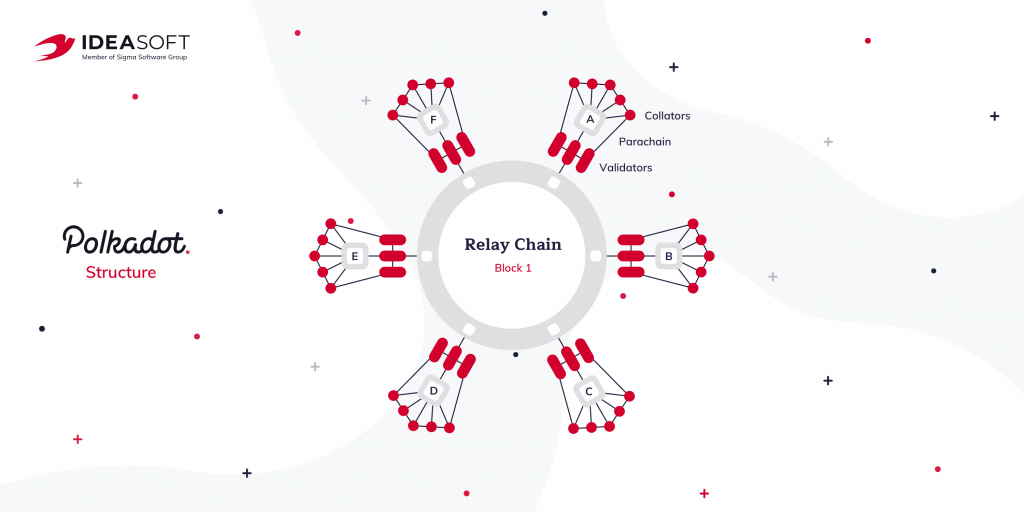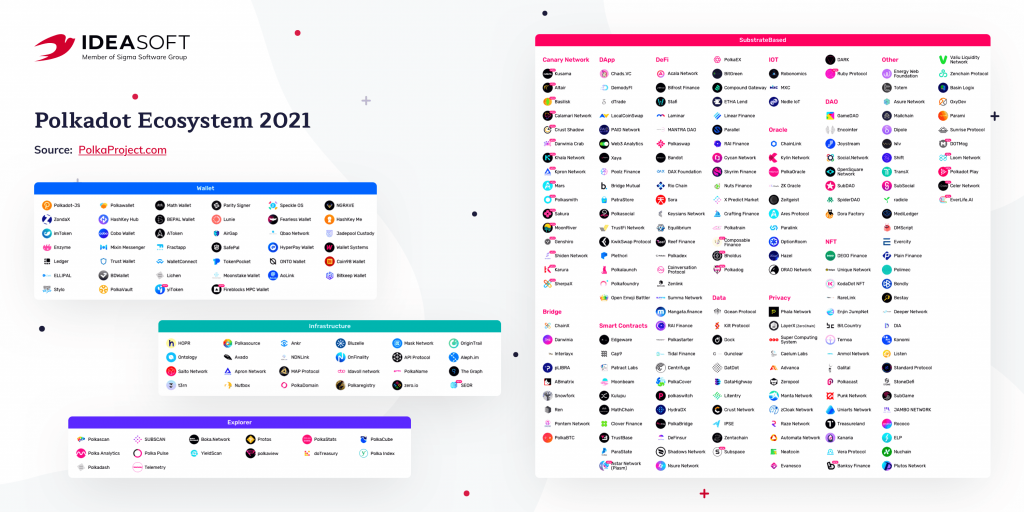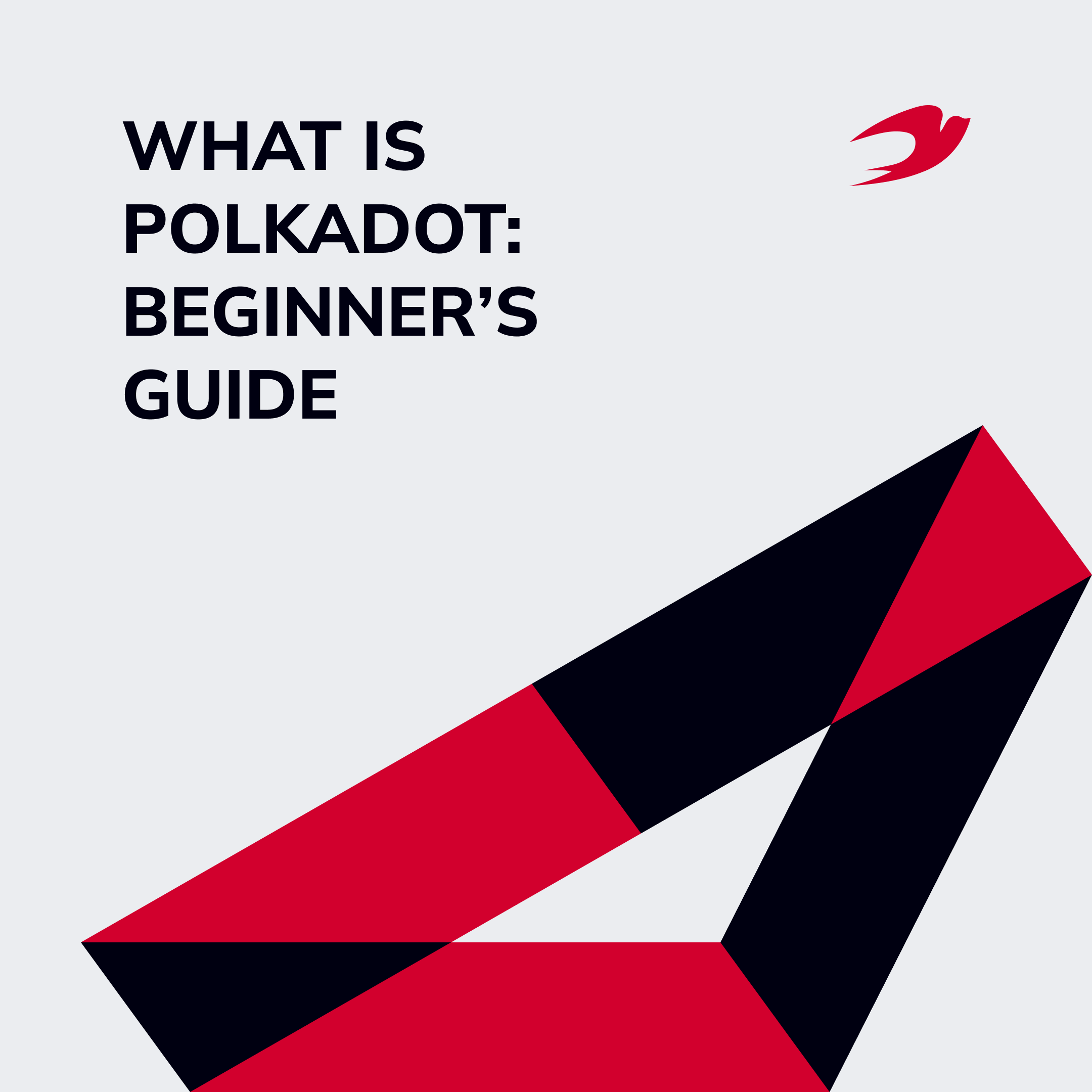Have you noticed that the mention of Polkadot is increasingly common in the blockchain community? That’s not surprising. As a technology designed to increase the interoperability of different blockchains, Polkadot opens up new opportunities for blockchain developers. We decided to explore this technology in detail and share our findings with you on what Polkadot is and what the features of Polkadot development are.
Table of contents:
- What is Polkadot
- How does Polkadot work?
- Blockchain development with Polkadot
- DOT explained
- Why Polkadot is gaining popularity
- The future of Polkadot
What is Polkadot
As mentioned, Polkadot is a technology designed to increase the interoperability of different blockchains and connect them into a single multi-blockchain network. Polkadot provides a platform within which new blockchains can be created as well as existing blockchains connected. It allows blockchain systems to process and transfer data quickly and securely while avoiding system-wide updates or hard forks.
The ultimate goal of Polkadot is to create a kind of framework for all blockchains similar to the HTML markup that allows websites, different browsers and servers to communicate with each other. This means that the Polkadot team is willing to take on all the “dirty” work, including the mining processes, and allow developers to focus on creating decentralized applications and smart contract functionality.
The main reason for Polkadot’s development was the inability of Ethereum to scale. This is why such projects as Polkadot and Polygon appeared. Polkadot is scalable and can transfer data both across public and private blockchains by combining them. The Polkadot network includes the following components:
- Relay Chain – the core of communication between shards that provides security.
- Parachains – autonomous blockchains that operate based on the Relay Chain.
- Parathreads – blockchains that are leased to users.
- Bridge Chain – bridges that connect and combine blockchains.

Polkadot allows you to create applications that take permission data from a private blockchain and use it in a public blockchain. For example, a private blockchain of a school’s academic records can send a confirmation to a smart contract to verify a degree in the public blockchain.
The development of Polkadot was done by Ethereum co-founder and CTO Gavin Wood, Web3 Foundation CTO Peter Czaban, and blockchain technology researcher and developer Robert Habermeyer.
How does Polkadot work?
Polkadot wants to be the foundation from which all other blockchains will grow. The team sincerely believes in the need to create a common ground for decentralized projects. The Polkadot network functions as three separate elements that allow it to address both interoperability and scalability:
- Polkadot does not provide a single blockchain that works with different applications. Instead, Polkadot provides the relay chain that acts as a foundation on which parachains with interoperability operate.
- Multiple parachains are placed on top of the relay chain. They are described as dynamic data structures placed in parallel with each other. Parachains are independent blockchains that collect and process their own transactions, although they are part of the Polkadot network.
- Other blockchains can communicate with the Polkadot network through bridges placed on the parachains. This is relevant when a blockchain must maintain its consensus and finality mechanisms. These are called bridge chains and allow the Polkadot network to connect to Cardano and Free TON blockchains, as well as many others.
Defective Polkadot parachains can be disabled. In cases when a parachain leaves the Polkadot network, it becomes a separate chain and cannot take advantage of the Polkadot unified security system. The Polkadot ecosystem uses the Nominated Proof of Stake (NPoS) protocol to protect it. Four groups of participants are involved in ensuring NPoS protocol:
- Nominators. They are essentially DOT holders who use tokens for staking, gaining the right to support a validation candidate. If a validator is selected, nominators who put their DOT tokens in support of the validator, also get a share of the rewards.
- Validators. They are responsible for securing the relay chain by utilizing their DOT tokens. They validate transactions that take place on different parachains and verify data coming from collators in the form of blocks, transactions, and messages. Validators are critical to the system because they help it evolve. If a validator behaves appropriately then new tokens are issued to them, but if they do something illegal, the DOTs they supply are confiscated.
- Collators. They work with validators. Collators are assigned to maintain a specific parachain. They collect transactions and link them into a block, which is then verified by the validator.
- Fishers. They are considered the last layer of security in Polkadot. Their job is to monitor unscrupulous behavior in the network without creating blocks. This is the easiest role in the network, and fishers are rewarded if they detect and report malicious behavior.
Blockchain development with Polkadot
Where to start with development on Polkadot? The blockchain development environment on Polkadot is called Substrate and is considered the easiest and most advanced environment for blockchain creation.
To deploy your own parachain, you can use the Cumulus framework (an extension to Substrate; also created by the Parity team), which makes it easy to build a new blockchain with Polkadot network support.
If you want to hire Polkadot developers, we recommend reading How to hire blockchain developers.
DOT explained
What is a Polkadot token? DOT cryptocurrency is a digital token that the network uses for staking. Staking is the process of earning cryptocurrency as a reward for storing funds in a digital wallet to keep the blockchain running. Stacking involves locking a certain number of tokens for a certain period of time.
Now let’s find out what role the Polkadot internal token plays in Polkadot`s distributed registry model. The coin has three main functions:
- Governance. The ecosystem’s internal cryptocurrency gives the owner a voice in making adjustments to the program code. Without the approval of Polkadot coin holders, no major event will occur on the blockchain.
- Functionality. DOT tokens are used to make bets and pay rewards to control nodes.
- Connectivity. Adding new parachains and removing inactive ones is paid with Polkadot cryptocurrency.
Polkadot does not provide mining of cryptocurrency. The issue of tokens at the start of the project was 10 million DOT, but in August 2020 there was a denomination – the number of coins was increased to 1 billion to facilitate the calculation of transactions. All coins in user wallets were multiplied by 100, resulting in 0.01 DOT turning into 10 DOT. Thus, the number of coins was significantly increased, but the token holders did not suffer or lose anything as a result of inflation.
Why Polkadot is gaining popularity
Polkadot is gaining popularity because the project aims to decentralize the Internet by connecting blockchains and allowing them to interact with each other, allowing the creation of new applications such as decentralized finance (DeFi). Here are some advantages of Polkadot:
- The versatility of functionality. Polkadot allows blockchains to transfer not only tokens but also assets (files) of various types.
- Access to a variety of blockchains.
- The possibility of creating your own blockchain.
- Security thanks to staking. In the Polkadot network, independent chains can interact with each other and not worry about their security as it is controlled by the use of staking.

There is no denying the potential that Polkadot has. Thanks to the new architecture that the project offers, the idea of solving scalability and interoperability problems starts to seem more realistic than before. It also shows the future trends of cryptocurrency development in general: in the case of mass adoption, higher transaction speed will be an absolute necessity.
Polkadot solves 3 problems:
- Scalability.
- No or limited communication and interchanging of data.
- Lack of customization.
The Polkadot network is a new project that can help with interoperability and scalability issues in the cryptocurrency industry and that’s why it has been in the spotlight lately.
The future of Polkadot
Polkadot is not the only platform focused on improving scalability, governance, and interaction. Nevertheless, Polkadot is a technology with fast-growing potential, which is ahead of similar projects with fast data transfers. Today, there are more than 450 projects on Polkadot. Of these projects more than 150 are Substrate based and the most popular among them are:
- Polkadot
- Kusama
- DatDot
- OceanProtocol
- Acala Network
Although Polkadot is relatively young, a large number of companies have already recognized its technology as quite interesting and profitable. Polkadot aims to create a decentralized blockchain network in which each block is autonomous and opens up more opportunities for blockchain startups. Many enthusiasts predict a bright future for Polkadot.
To finish, here are some facts about Polkadot development:
- On June 18, 2020, the Polkadot blockchain started to use Nominated Proof-of-Stake (NPoS).
- On July 20, 2020, the Web3 Foundation resigned as the administrator of the Polkadot network.
- On August 4, 2020, Polkadot developers launched the Rococo test network to implement parachain sharding.
Don’t forget to subscribe to the IdeaSoft blog to stay tuned for the latest technology trends.

